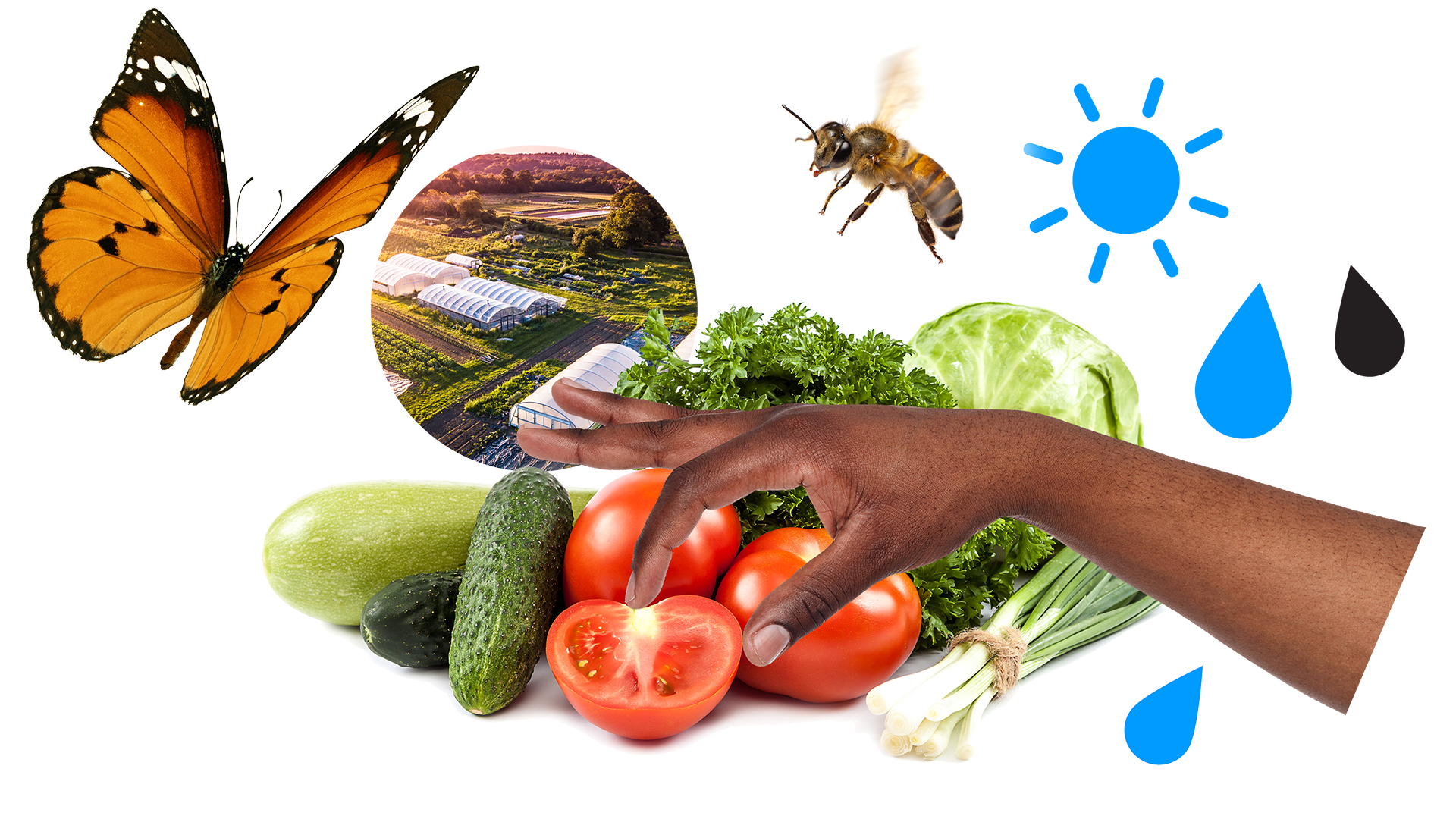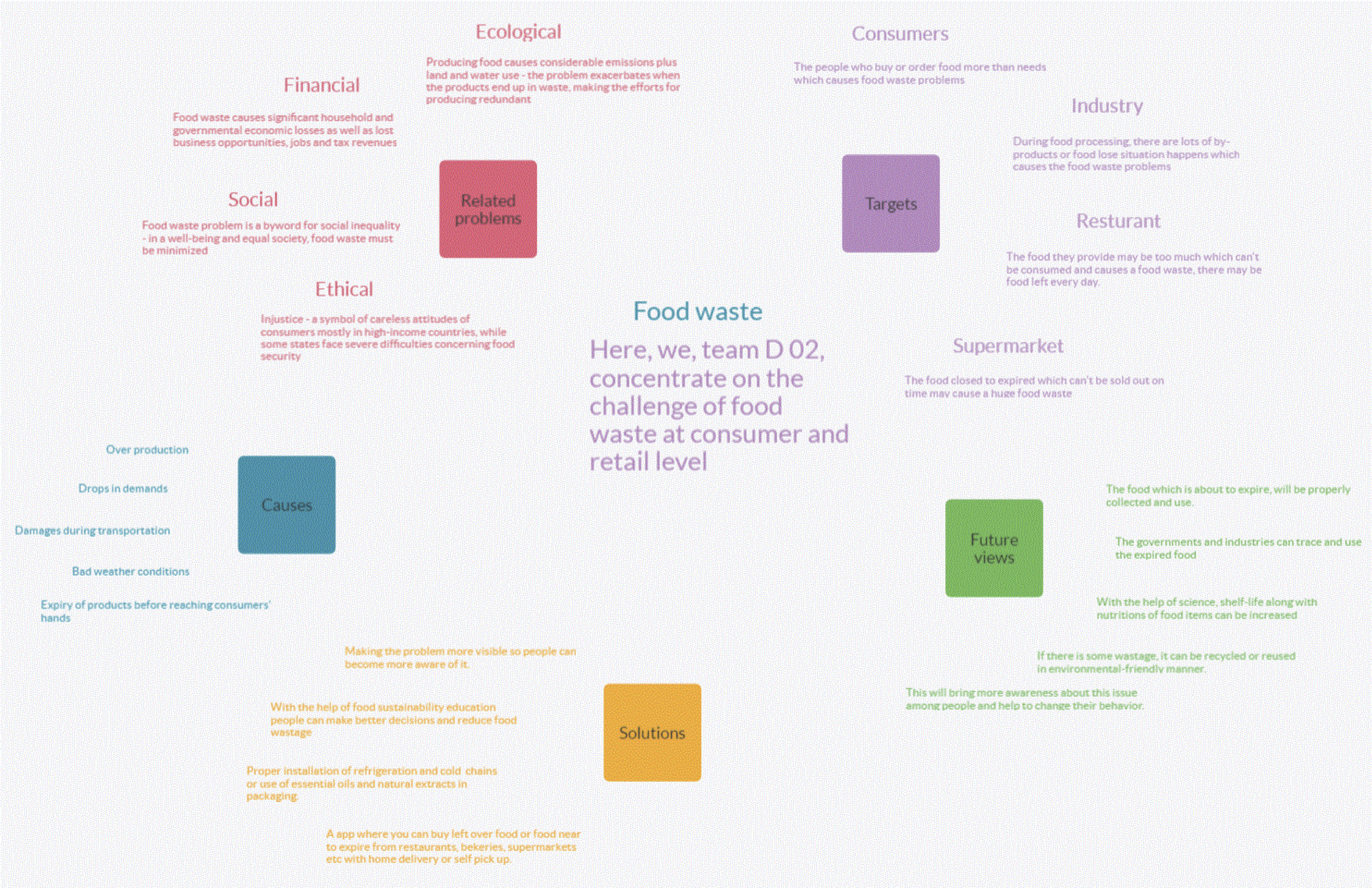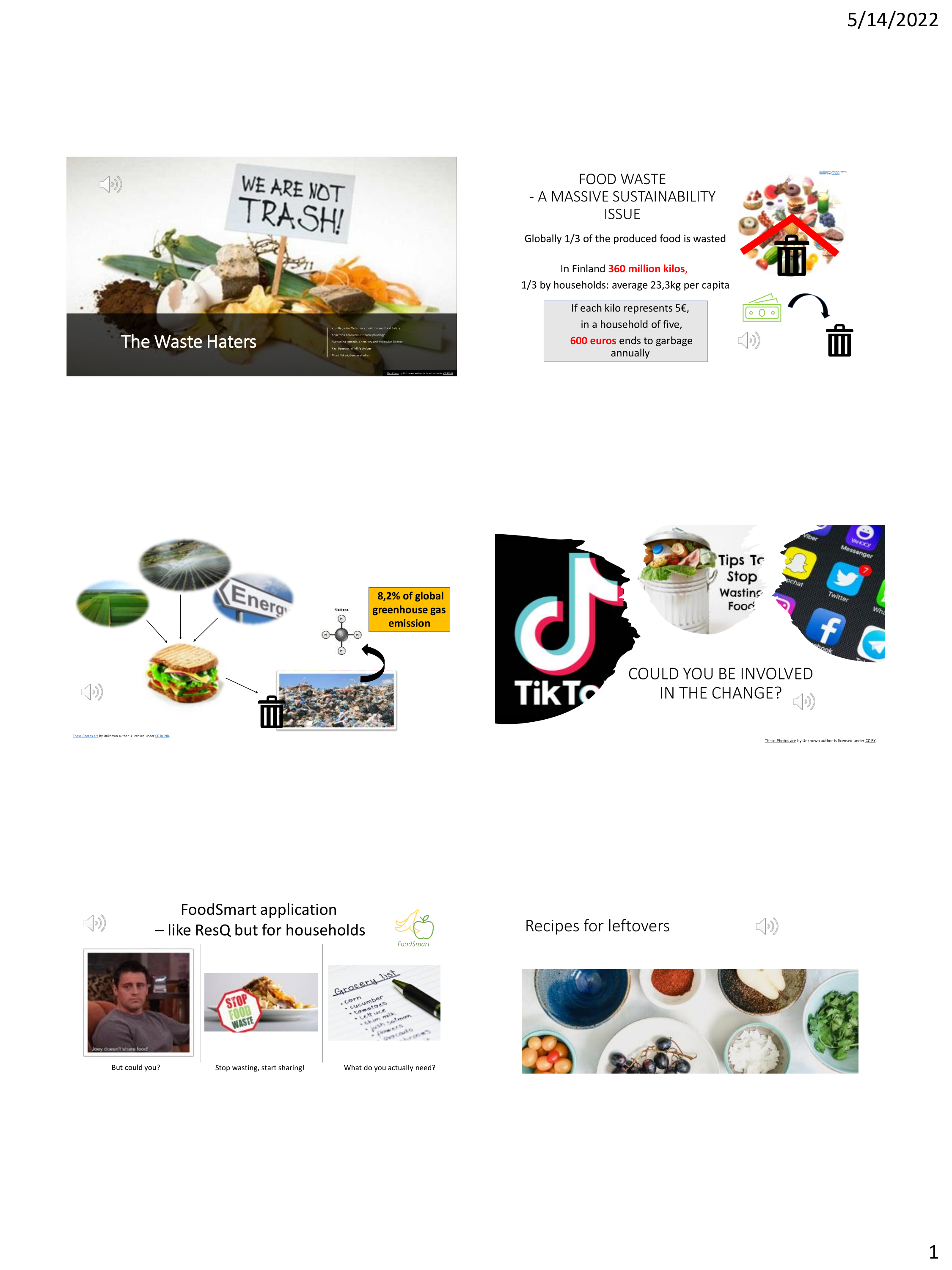
Group D02: Food Waste Warriors
Objective: The term ’food waste’ is generally referred to products that have reached the end of the food chain, i.e. retail and consumers, and are at that point consciously thrown away (FAO, 2011). The problem is exacerbated from lower-middle-income to high-income countries, where the amount of food discarded in households, food service and retail, respectively, constitute as much as 17% of the total food produced globally (UNEP, 2021).
Short description: The main theme here is comprehensiveness, which means the app, reachable for anyone, engages its users in a low-waste lifestyle by offering affordable food nearby and actively suggesting ways of preventing food waste, rewarding it’s users for making environmentally friendly choices and sharing them with friends – therefore contributing to ecological, economical and social sustainability.

(click canvas to enlarge)
Elevator pitch:
(click image to enlarge)
Sources:
UN Environment Programme (2021). Food Waste Index Report 2021.
FAO (2011). Global food losses and food waste Extent, causes and prevention. Rome.
EPA United States Environmental Protection Agency (2021). https://www.epa.gov/international-cooperation/international-efforts-wasted-food-recovery
5 facts about food waste and hunger | World Food Programme (wfp.org) https://www.wfp.org/stories/5-facts-about-food-waste-and-hunger
Welcome to WeFood, Finland’s first ever supermarket selling surplus food Kirkon Ulkomaanapu. https://wefood.fi/finn-church-aid-opens-finlands-first-ever-supermarket-selling-surplus-food/
Photo source: Office365 Powerpoint Stock Photos
Group D09: The Waste Haters
Objective: To identify the drivers and barriers of food waste and explore possible solutions to food waste reduction at the consumer level.
Short description: Our idea is to use social media platforms like TikTok and Instagram, and influence people’s behavior and habits. We would also like to see modern phone applications that could connect people living close to each other and allow sharing food products that may otherwise get wasted. Application could also have other features to help reduce the food waste: Zero waste shopping list and tips how to use ingredients already at home. The goal is to decrease food waste at the household level.
(click canvas to enlarge)
Elevator pitch:
(click image to enlarge)
Sources:
Gustavsson Jenny, Cedenberg Christel, Sonesson Ulf (2011). Global Food Losses and Food waste https://www.fao.org/3/i2697e/i2697e.pdf
Mikkonen K. (2021) Elintarvikkeiden säilyvyys. Lecture in University of Helsinki. Food science.
Tamar Makov Alon Shepon, Jonathan Krones Clare Gupta Marian Chertow (2020). Social and environmental analysis of food waste abatement via the peer to peer sharing economy https://www.nature.com/articles/s41467-020-14899-5
UN Environment Programme.Food Waste Index Report 2021
https://www.unep.org/resources/report/unep-food-waste-index-report-2021 4/2022
UN Stop Food Loss and waste, for the people, for the planet.
https://www.un.org/en/observances/end
food waste day#:~:text=When%20food%20is%20lost%20or,emissions%2C%20contributing%20to%20climate%20change. 4/2022
Pan Wang, Hongtao Wang, Yinquan Qiu, Lianhai Ren, Bin Jiang (2018). Microbial characteristics in anaerobic digestion
process of food waste for methane production – A review. DOI: 10.1016/j.biortech.2017.06.152
Group D10: STOP the food waste!
Objective: The object/aim of the project is to look at the food waste produced by the restaurant sector. A large part of the food waste in restaurants is the food waste generated in the line service (linjastotarjoilu), the customer takes too much food on the plate and some of it goes to the trash. Restaurants can really make a big difference in the food waste at all stages of the process. For example good menu, preparation and purchase planning plays a key role in this. It´s also very important to increase customer awareness of food waste and for example the use of seasonal ingredients. Good solutions have been developed to avoid food waste, such as food waste applications and restaurants. However, these also have their own problems, as no company works without results and when doing so, sustainable values may be forgotten.
Short description: The main idea is to create a service/platform which provides current information, tools and practical ideas how to reduce food waste and develop food products to be more sustainable as well as how to sell or utilize waste food efficiently. Platform plan:
1. Information about products and ingredients and the efficient use of them: sustainable choices, food preparation methods, seasonal ingredients.
2. Carbon footprint calculator (where you can calculate the footprint for single ingredient, dish or the whole menu) which you can also use in marketing your services.
3. Menu and purchase planning tools.
4. What to do with the waste food?
(click canvas to enlarge)
Elevator pitch:
(click image to enlarge)
Sources:
Kirveennummi,A.Mäkelä,J.Saarimaa,R.(2013).Beating unsustainability with eating: four alternation food-consumption scenarios. Sustainability: Science, practice & policy: Vol 9/2.
Riipi,I.,Hartikainen,H.,Silvennoinen,K.,Joensuu,K.,Vahvaselkä,M., Kuisma, M. & Katajajuuri, J-M. (2021). Elintarvikejätteen ja ruokahävikin seurantajärjestelmän rakentaminen ja ruokahävikkitiekartta. Luonnonvara- ja biotalouden tutkimus 49/2021. Luonnonvarakeskus, Helsinki.
Salonen,A.(2021).10teesiä Arjen ympäristöaktivismista. Arjen ympäristöaktivismi – Arto O. Salosen yleisöluennon materiaali. Luettu 20.4.2022. hSps://enactresearchproject.files.wordpress.com/2021/02/salonen-10-teesia.pdf
Silvennoinen, K. Nisonen, S. Lahti, L. (2019). Ravitsemispalveluiden elintarvikejäte. Luonnonvarakeskus, Helsinki.
THEMATIC MODULE D: Sustainable food systems and healthy nutrition. Sustainability course, spring 2022. MOOC-platform.
Ulkoministeriö.(2020). Agenda2030 – kestävän kehityksen tavoitteet. Luettu 20.4.2022. hSps://um.fi/agenda-2030-kestavan-kehityksen- tavoitteet
Kirveennummi,A.Mäkelä,J.Saarimaa,R.(2013).Beating unsustainability with eating: four alternation food-consumption scenarios. Sustainability: Science, practice & policy: Vol 9/2.
Riipi,I.,Hartikainen,H.,Silvennoinen,K.,Joensuu,K.,Vahvaselkä,M., Kuisma, M. & Katajajuuri, J-M. (2021). Elintarvikejätteen ja ruokahävikin seurantajärjestelmän rakentaminen ja ruokahävikkitiekartta. Luonnonvara- ja biotalouden tutkimus 49/2021. Luonnonvarakeskus, Helsinki.
Salonen,A.(2021).10teesiä Arjen ympäristöaktivismista. Arjen ympäristöaktivismi – Arto O. Salosen yleisöluennon materiaali. Luettu 20.4.2022. hSps://enactresearchproject.files.wordpress.com/2021/02/salonen-10-teesia.pdf
Silvennoinen, K. Nisonen, S. Lahti, L. (2019). Ravitsemispalveluiden elintarvikejäte. Luonnonvarakeskus, Helsinki.
THEMATIC MODULE D: Sustainable food systems and healthy nutrition. Sustainability course, spring 2022. MOOC-platform.
Ulkoministeriö.(2020). Agenda2030 – kestävän kehityksen tavoitteet. Luettu 20.4.2022. hSps://um.fi/agenda-2030-kestavan-kehityksen- tavoitteet
Other Groups (unpublished assignments)
These project assignments are not public, but if you’re a Sustainability Course (SUST-001B) Spring 2022 student, you may access them in Mooc using the links below:
D03: Team Local (Increasing the consumption of local food in Finland)
D04: Foodaholics (Reducing food waste)
D05: Muovinkorvaajat (Replacing plastic-based packaging with wood-based packaging)
D06: Team NETTLE (Creating a more sustainable production and consumption of vegetables)
D07: Pupunruoka (The environmental and cultural sustainability of a plant-based diet in Finland)
D08: Kasviksia kestävästi (Reducing waste that comes from harvesting)




